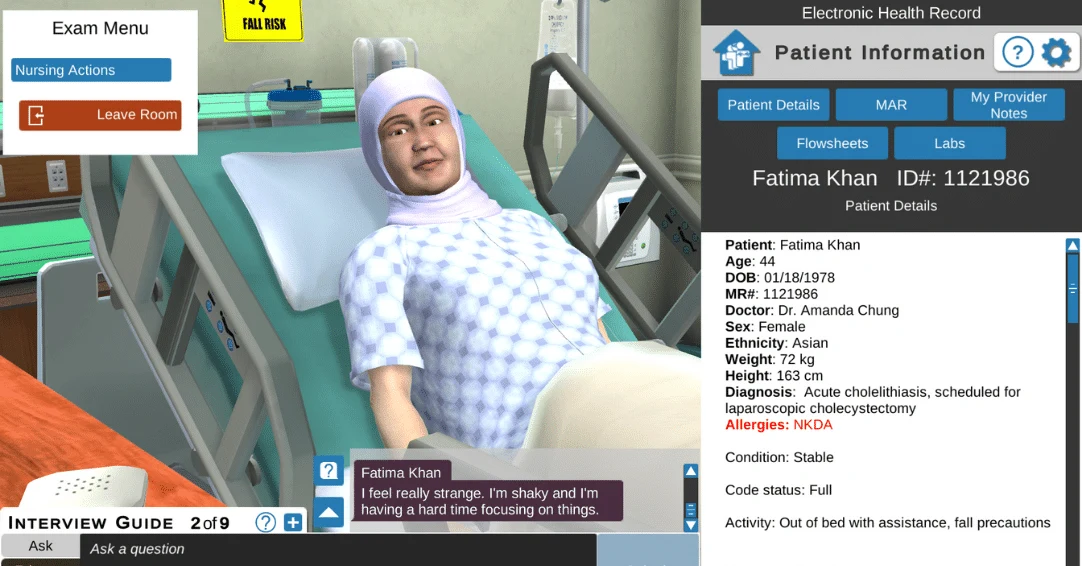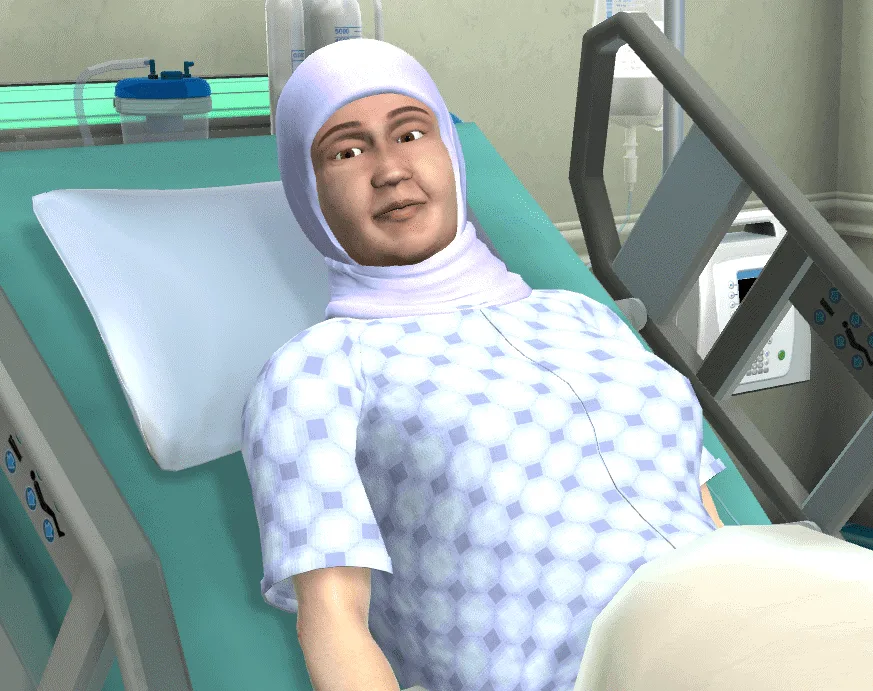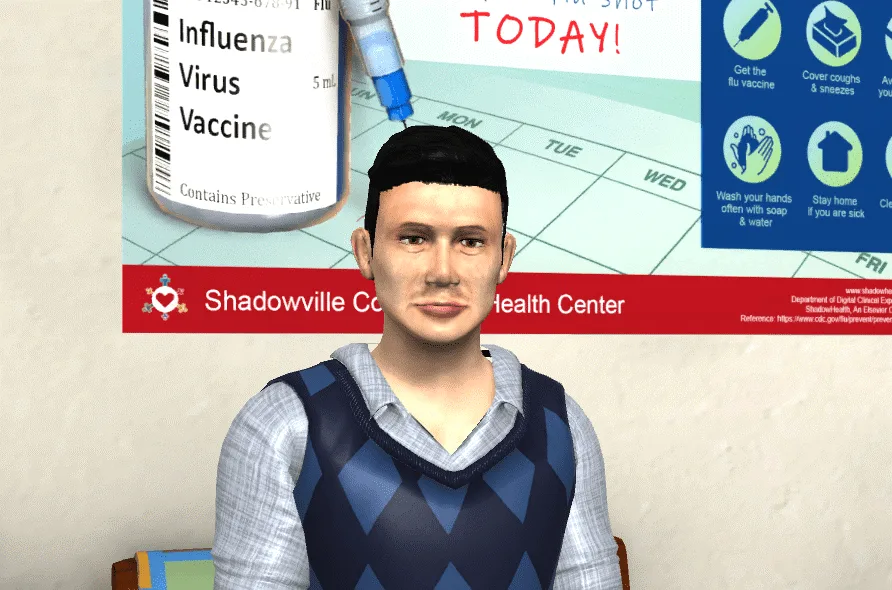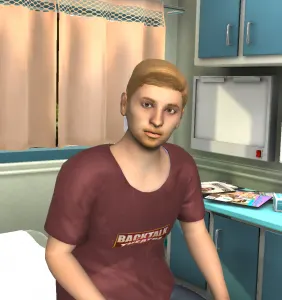Reflecting US diversity through Shadow Health’s virtual patient population
25 mai 2022 | Lecture de 11 min
Par Elsevier Connect contributors

New graduate nurses can practice authentic conversations with a diverse representation of patients that they may not see in the clinical setting.
Elsevier’s Shadow Health has a wide range of simulated virtual patients that allow novice nurses to practice clinical skills from Medical-Surgical to Mental Health . Because of the patented natural language Conversation Engine within Shadow Health, your new graduate nurses can practice authentic conversations with a diverse representation of patients that they may not see in the clinical setting.
Elsevier understands the importance of allowing new nurses the opportunity to interact with patients in a respectful, meaningful, and accurate way. It takes a large team of collaborators to create screen-based simulation offerings—including a cross-functional team of Nurse Educators, Developers, Artists, Technical Sound Designers, Learning Designers, Narrative Designers, Product Managers, and Scrum Managers. They make it their priority to incorporate optimal learning opportunities with realistic conversation and empathy to each of the simulated patients to truly make them virtual human beings who breathe, blink, and have rich and complex histories.
Additionally, Elsevier partners with external experts and agencies to ensure diverse personas are presented respectfully. Creating virtual patients that represent a variety of backgrounds and cultures allow learners to practice conversation skills and empathy on patients, as well as therapeutic communication. Screen-based simulation guarantees that learners can interact with patients from a wide range of backgrounds and experiences, and can consider patient needs along with social determinants of health.
Here are some examples of virtual patients in Shadow Health representing diverse backgrounds and ensuring learners can practice therapeutic communication.
Daanis LaFontaine
Daanis LaFontaine, 18, is a member of the Turtle Mountain Band of Chippewa Indians, an Ojibwe people. Assignments featuring Daanis and our other Native American characters were developed in partnership with Dr. Misty Wilkie, an enrolled member of the Turtle Mountain Band of Chippewa Indians and a nurse who grew up on the Turtle Mountain Indian Reservation in Belcourt, North Dakota.

Daanis LaFontaine and her mother, Rebecca LaFontaine
Dr. Wilkie is a nurse educator who teaches at Bemidji State University and has now served as a consultant on three different modules for Shadow Health. When developing Daanis, Dr. Wilkie and the development teams were able to exchange questions and ideas which resulted in whole, authentic, and accurate representations of these patients.
For example, Daanis’s name was chosen with special care and consideration. “Daanis” means “daughter” in the Ojibwe language. “LaFontaine” captures the Metis French influence on the Turtle Mountain people.
Daanis appeared first in the Maternal Health module. She is in labor with her son Zachary, and her mother, Rebecca LaFontaine, is in the room with her. Your new graduate nurses will learn about Daanis’s birth plan preferences and transcultural considerations such as allowing additional family members into the room, restricting and respecting considerations around touch, and honoring her request to take the placenta home.
Shadow Health’s development team also partnered with a local artist from the Turtle Mountain Band of Chippewa Indians to create the initial concept art for Daanis LaFontaine and her mother, Rebecca. For example, in the simulation, Rebecca is wearing a traditional ribbon skirt, a symbol of womanhood and pride among many Ojibwe communities.
Fatima Khan
In the Medical-Surgical module, learners meet Fatima Khan, a 44-year-old type 1 diabetic who is pre-operative and awaiting a laparoscopic cholecystectomy. As part of this simulation, novice nurses practice healthcare considerations that may be important to Muslim patients, including diet, modesty and privacy, touch restriction and consent, and substance use restriction.

Fatima Khan
To develop Fatima’s character, the Shadow Health team drew upon published research and best practices for South Asian/Muslim patients in hospital settings. Muslim women in particular report provider bias, and a lack of sensitivity or understanding around concepts of modesty and dress. To accommodate Fatima’s needs and because the hijab does not obstruct or interfere with the surgery site, Fatima wears her hijab during the operation.
Learners interview the patient and are challenged with recognizing a change in patient status. In this simulation, Preceptor Diana remains present in the room during the patient assessment to fulfill the patient’s request of having a same-gender provider present. Using clinical reasoning to implement safe, effective, patient-centered care, learners create a culturally appropriate care plan for Fatima.
Quan Van Tran
When new graduate nurses first meet Quan Van Tran, 50, they encounter him in a clinical setting shortly after he has received a positive diagnosis of HIV. Quan is a Vietnamese American who immigrated to the United States. In previous years S’ouvre dans une nouvelle fenêtre, research shows the number of HIV diagnoses among Asians in the U.S. increased, and 1 in 5 Asians living with HIV in the U.S. did not know they had it. Quan also does not think of himself in terms of sexual orientation. His assignment is imbued with a need for learners to demonstrate cultural humility. HIV is a sensitive topic and the depth of history required for contact tracing may also be challenging for new nurses. He is featured in Community Health Module.

Quan Van Tran
When obtaining a patient’s sexual history, it would be inappropriate for learners to ask Quan to think of himself in terms of his sexual orientation and will push back if learners continuously ask inappropriate questions about his identity instead of appropriate questions about his sexual history. This is a feature in Shadow Health that makes learners think carefully about obtaining patient history and obtaining medically relevant behavior.
Studies show nurses often lack the proper education to adequately provide safe and competent care to the LGBT+ community (Kroning et al., 2018). It was important to the Shadow Health team to call attention to a specific vulnerable and underrepresented population. This character was developed with a nursing expert from the Vietnamese American Nurses Association. His demographics as an older Asian American man represent a growing population for new HIV infections, which is underrepresented in healthcare education.
Additionally, Elsevier recently conducted research, published in Clinical Simulation in Nursing S’ouvre dans une nouvelle fenêtre, to determine if virtual patient simulations can effectively teach nursing learners about patient care issues they may not encounter as part of their clinical education. The team focused specifically on a patient living with HIV, recognizing that people living with HIV face stigma and discrimination in society at large and in the healthcare system itself. Findings suggest that participation in a virtual simulation of a patient living with HIV can positively impact nursing learners’ attitudes.
Tanner Bailey
Tanner Bailey is a 30-year-old transgender man who works as a theatre director at a queer theatre company. In his spare time, he loves working out and watching old movies. He is proactive about his health and happiness. Tanner appears in the Community Health module where cases highlight the difficulties trans people face on a daily basis due to unjust bias including regular discrimination in health care and the job sector. Bias against transgender and gender diverse (TGD) people in healthcare can lead to significant health disparities and limited access to appropriate care (Sherman et al., 2021).

Tanner Bailey
For Tanner’s appearance in the Community Health module, Shadow Health worked with a leading consulting firm, Trans Equity Consulting, that has experience with medical simulation and deep ties and experience in the LGBT+ communities. With their guidance, Shadow Health’s development teams crafted a whole, authentic representation of Tanner and his experiences in Shadowville.
Tanner’s simulation includes a Rapport Building activity—according to consultant input, establishing rapport with a trans client is extremely important during a visit. This population has often had negative experiences in the healthcare system—research shows S’ouvre dans une nouvelle fenêtre that 25% of trans patients report delaying healthcare-seeking out of fear of mistreatment and discrimination. Building trust before entering into the interview and exam is important. Examples of microaggressions against trans patients that could appear in the healthcare setting, including misgendering or refusing to use a patient’s name, are addressed in the Rapport Building activity.
New nurses practice invaluable communication skills in this activity: introducing themselves with their pronouns and asking for Tanner’s; establishing how Tanner would like to be referred to, which is an important element for establishing trust with patients who may use a different name than their legal name; determining what terms Tanner prefers for referencing his anatomy (he prefers “chest” instead of “breast”); and discussing Tanner’s preferences for physical examination prior to beginning the exam. While these are small steps towards building rapport with patients from vulnerable populations, they have the potential to make a big impact on building rapport with a population that reports experiencing high levels of discrimination and microaggression in healthcare settings.
Eden Woo
In the Pediatrics module, learners have the opportunity to interact with Jennifer, Vivian, and their daughter Eden. Though you may recognize one of Eden’s mothers from the maternal health gestational diabetes lesson, nurses care for Eden as a 3-month-old infant during a visit to the emergency department for RSV.

Jennifer, Vivian, and their daughter Eden
Though the focus is on baby Eden, they learn about some difficulties surrounding family planning that LGBT+ couples face, and support received via the Shadowville queer community.
This assignment also includes learning moments for learners about inequities in healthcare. As a mother, Jennifer returns to work after pregnancy leave to provide for her family, alongside Vivian, leaving her career to stay at home to care for Eden. Part of the nurse’s role in this simulation is to not only provide the parents with education around infant care but also care for an individual who cannot speak for themself.
Abigail Harris
Abigail Harris is an 86-year-old Black woman who appears in the Mental Health module. Abigail has been experiencing fatigue and weakness that has impaired her activities of daily living for about a month and has had her symptoms dismissed as ‘old age’.

Abigail Harris
As an older patient, learners should be mindful of how they interact with Abigail to avoid implicit ageism. Ageism in the healthcare setting can impact adequate care, prevalence of health conditions, and healthcare costs (Levy et al, 2018). Additionally, discrimination is even more prevalent among older minority individuals particularly as it relates to delayed care and poor communication (Rhee et al, 2019). In these simulations, nurses must remain aware of how implicit bias toward race, gender, and age may impact interpretation of a patient’s signs and symptoms throughout the nursing process.
In the Mental Health module, Abigail is one of six patients that learners care for at Shadow General Hospital (and a clinic visit). They must apply several conversational concepts, including asking sensitive questions regarding suicidal ideation, self-harm, and risk for violence. For Abigail, this means evaluating her condition from a holistic standpoint along with a mental status exam to ensure positive outcomes for patient care.
What this means for new graduate nurses
Research indicates that change is necessary for healthcare to eliminate bias, reduce health disparities, and consider the impact of social determinants of health for patient care (Carter, 2020). While preceptors can guide novice nurses on social context or special considerations to keep in mind during a patient interaction in the clinical setting, learners can practice interacting with virtual human beings from different backgrounds and engage in thoughtful, empathetic communication through means like screen-based virtual simulations. This not only streamlines learning but guarantees they have the opportunity to practice respectful interactions with a diverse range of patients.
Contributions and revisions of this piece were done in part with Watson Nelson Consulting S’ouvre dans une nouvelle fenêtre, a partner with Elsevier’s Shadow Health to ensure matters of diversity, equity, and inclusion are accurately represented with simulation characters.
Resources
Altmiller, G., Jimenez, F., Wharton, J., Wilson, C. (2022). HIV and Contact Tracing: Impact of a Virtual Patient Simulation Activity. Clinical Simulation in Nursing, 64. 58-66. https://doi.org/10.1016/j.ecns.2021.12.005 S’ouvre dans une nouvelle fenêtre
Carter, B. (2020). Achieving diversity, inclusion and equity in the nursing workforce. Revista latino-americana de enfermagem, 28, e3254. https://doi.org/10.1590/1518-8345.0000-3254 S’ouvre dans une nouvelle fenêtre
CDC. (2022, April 14). HIV in the United States by Race/ethnicity. Centers for Disease Control and Prevention. Retrieved May 5, 2022, from https://www.cdc.gov/hiv/group/racialethnic/other-races/ S’ouvre dans une nouvelle fenêtre
Felias-Christensen, G, Corl, D. (2010, January 1). Muslim Religious Observances and Diabetes. Retrieved from https://ethnomed.org/resource/muslim-religious-observances-and-diabetes/ S’ouvre dans une nouvelle fenêtre
Kcomt, L., Gorey, K. M., Barrett, B. J., & McCabe, S. E. (2020). Healthcare avoidance due to anticipated discrimination among transgender people: A call to create trans-affirmative environments. SSM – Population Health, 11, 100608. https://doi.org/10.1016/j.ssmph.2020.100608 S’ouvre dans une nouvelle fenêtre
Kroning, M. (2018) Lesbian, Gay, Bisexual, and Transgender Education in Nursing. Nurse Educator, 43(1), 41. https://doi.org/10.1097/NNE.0000000000000429 S’ouvre dans une nouvelle fenêtre
Lynn, V., Watson, C., Giwa-Onaiwu, M., Ray, V., Gallagher, B., & Wojciechowicz, V. (n.d.). HIV #LanguageMatters: Addressing Stigma by Using Preferred Language. HIVE. Retrieved March 10, 2022, from https://hiveonline.org/wp-content/uploads/2016/01/Anti-StigmaSign-Onletter-1.pdf S’ouvre dans une nouvelle fenêtre
Patterson, J. G., Tree, J. M. J., Kamen C. (2019). Cultural competency and microaggressions in the provision of care to LGBT patients in rural and appalachian Tennessee. Patient Education and Counseling, 102 (11). 2090. https://doi.org/10.1016/j.pec.2019.06.003 S’ouvre dans une nouvelle fenêtre
Pew Research Center. (2011, August 30). Muslim americans: no signs of growth in alienation or support for extremism. Section 1: a demographic portrait for muslim americans. Retrieved from: https://www.pewresearch.org/politics/2011/08/30/section-1-a-demographic-portrait-of-muslim-americans/ S’ouvre dans une nouvelle fenêtre
Pew Research Center. (2018, April 17). Muslims in America: Immigrants and those born in U.S. see life differently in many ways. Retrieved from: https://www.pewforum.org/essay/muslims-in-america-immigrants-and-those-born-in-u-s-see-life-differently-in-many-ways/s S’ouvre dans une nouvelle fenêtre
Sherman, A. D., McDowell, A., Clark, K.D., Balthazar, M., Klepper, M., Bower, K. (2021) Transgender and gender diverse health education for future nurses: Learners’ knowledge and attitudes. Nurse Education Today. https://doi.org/10.1016/j.nedt.2020.104690 S’ouvre dans une nouvelle fenêtre
Contributeur

ECC